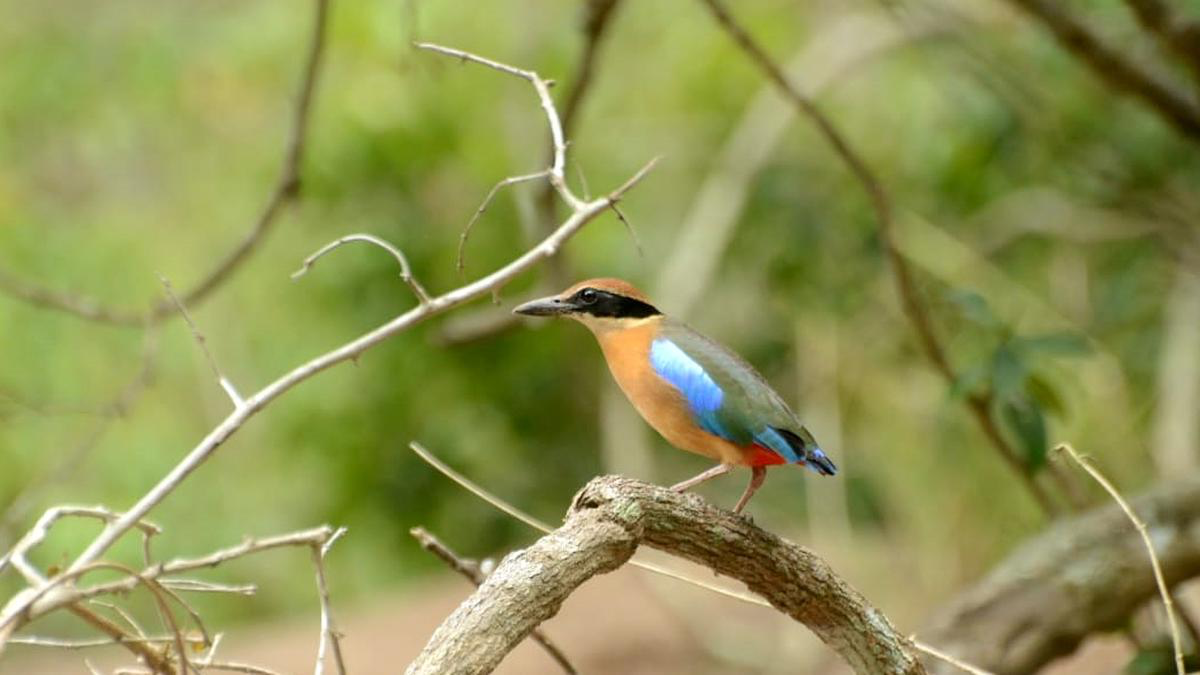Description

Disclaimer: Copyright infringement not intended.
Context
- In a first-ever census of mangrove pitta birds carried out in two coastal districts of Odisha, 179 such birds were sighted.
About Mangrove pitta birds
- They are a nearly threatened species found in few pockets of eastern India, including Odisha’s Bhitarkanika and West Bengal’s Sundarbans.
- These pittas are monotypic species.
- The mangrove pitta (P. megarhyncha) is closely related to blue-winged pitta (P. moluccensis) and was considered conspecific with P. moluccensis.
|
QUICK FACTS
- Scientific name: Pitta Megarhyncha
- Kingdom : Animalia
- Phylum : Chordata
- Class : Aves
- Order : Passeriformes
- Family : Pittidae
- Genus : Pitta
- Species : P. megarhyncha
- Distribution: India, Bangladesh, Myanmar, Thailand, Malaysia, Singapore, Indonesia
- Diet and feeding habits: crabs, other crustaceans, molluscs, beetles, ants, termites, insect larvae
- IUCN status listing: Near Threatened (NT)
|
Appearance
- The mangrove pitta is a small mangrove bird, measuring 18 to 20 cm in length and weighing 90 to 120 grams.
- The adult mangrove pitta has a grayish brown cap with indistinct thin blackish or gray median stripe.
Origin, geographical range and distribution
- The mangrove pitta species are distributed in India, Bangladesh, Myanmar, Thailand, Malaysia, Singapore and Indonesia.
- In India and Bangladesh they occur in the Sundarban Mangroves. In Myanmar, Thailand and Malaysia these species occur on the western coasts.
- In Sumatra (Indonesia) they are distributed on the eastern coast.
-min.jpg)
Ecosystem and habitat
- These species have moderate forest dependence.
- They normally occur in altitudes from 0 to 100 meters.
- The natural ecosystems and habitats of these mangrove species include, tropical and subtropical mangrove forests, tropical and subtropical wetlands, rivers, coastal marshlands, streams, creeks and estuaries.
Diet and feeding behavior
- The diet of these birds consists mainly of molluscs.
- Crustaceans, crabs, beetles, ants, termites, insect larvae are their primary food.
- They forage on the mangrove forest floor and take rest in trees and shrubs during high tide.
Migration and movement patterns
- These mangrove pitta species are non-migratory resident birds.
- Post breeding, the juveniles may disperse and establish in new locations within the range.
Conservation and survival
- Mangrove habitat alteration and destruction and development of aquaculture facilities along the coast are the main threats that are endangering the survival of this species.
IUCN and CITES status
- The mangrove pitta is approaching the thresholds for being Vulnerable under the range size criterion, under the population trend criterion and under the population size criterion.
- The IUCN (International Union for Conservation of Nature) has categorized and evaluated the species and has listed it as "Near Threatened".
- The CITES (Convention on International Trade in Endangered Species of Wild Fauna and Flora) status is ‘Not Evaluated’ for mangrove pitta.

About Bhitarkanika
- Bhitarkanika, lying in the estuarine region of Brahmani-Baitarani rivers in the North-Eastern corner of Kendrapara district of Odisha, is the second largest viable mangrove eco-system of India.
- This huge area of mangrove forests and wetland is intersected by a network of creeks with Bay of Bengal on the East.
- It houses some 215 species of birds, including wetland migrants from central-Asia and Europe, menacing salt water or estuarine crocodiles, and a lot of other fauna species like spotted deer, hyenas, fish cats, leopard cats, and big monitor lizards.
- Bhitarkanika includes Bhitarkanika Wildlife Sanctuary, Gahirmatha Marine Sanctuary and Bhitarkanika National Park in Odisha.
Bhitarkanika Wildlife Sanctuary
- The Sanctuary, which comprises of mangrove forests with diverse variety of mangrove flora species, has rivers meandering through it making several channels of different dimensions.
- The Sanctuary was formed to conserve the endangered salt water crocodiles, also called estuarine crocodiles.
- Besides estuarine Crocodiles, the Sanctuary is rich in avifauna, mammalian and reptilian population.
Gahirmatha Marine Sanctuary
- Stretch of water body from old light house near Batighar to Maipura river mouth was declared as Gahirmatha Marine Sanctuary in 1997.
- This is world’s largest known rookery of Olive Ridley sea turtle.
- Gahirmatha Sanctuary has a stretch of virgin beach from Barunei mouth to Ekakula.
- The entire sanctuary area comes within the revenue district of Kendrapara.
|
PRACTICE QUESTION
Q) How many of the following statements with reference to Mangrove Pitta birds is/are incorrect?
a. These are non-migratory resident birds.
b. They are a critically endangered species as per IUCN list.
c. The mangrove pitta species are distributed in India, Bangladesh, Myanmar, Thailand, Malaysia, Singapore and Indonesia.
- Only 1
- Only 2
- Only 3
- None of the above
Correct Answer: 1
|

https://www.thehindu.com/news/national/other-states/first-ever-census-finds-179-mangrove-pitta-birds-in-two-coastal-odisha-districts/article66747445.ece
















